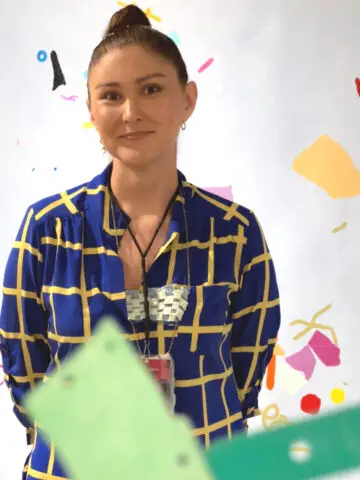The work represents the plastic fragments that float in the sea and run aground on the sand, and which are very attractive to marine animals and birds ingest them by accident. Metaphorically, Herencia speaks of the seductive capacity of these materials, of versatile and resistant qualities, in which the contradictions of our time are woven around what plastic solves in our daily lives, but at the same time it affects life and contaminates the environment. around.
Herencia mentions “although we all know in general terms that there are plastics floating in the ocean, it is very different when you live in the area and also see the real and daily impact. You feel them in your body. I discover this on my daily walks on the beach, which increasingly has more plastics, and also thanks to the dialogue with collective efforts in the area that seek alternatives to address this problem.”
The work titled “What are those floating spots?” It arises from questions, curiosity about the environment and the constant action of collecting discarded plastics on the beaches of Costa Rica, which is promoted as one of the best tourist destinations for its nature and beaches. In fact, the plastic fragments included in the work were collected over a period of two years, during private collections and also from a collaboration with the NGO in favor of the preservation of water quality in the south of the Nicoya Peninsula, Nicoya Peninsula Waterkeeper, in Cóbano.
The artist seeks with her work to make people reflect on the different aspects of human creation and an environmental problem that is increasing and that is making us all sick. It is for this reason that, in this work suspended between the limits of painting and installation, Herencia incorporates plastic waste as if painting in space, creating a multicolored space, at the same time that it converts a reality into a pictorial work.
Delving into the project
“Ask myself: What are those spots that float? and delving into this project, which more than a work is a journey of reflections, led me to discover the impact of microplastics. It is urgent to raise awareness about the impact of this material on the oceans. Since the appearance of plastic in the world economy, this material has been silently invading the planet’s oceans and beaches, reaching levels currently unimaginable. This material has even formed large islands in the middle of the oceans that concentrate thousands of tons of plastic and is also present throughout the planet,” Herencia mentions.The exhibition is open to the public for free at the Tijuana Cultural Center, Mexico, until February 2025.
About the Tijuana Triennial
For more than four decades, the Tijuana Cultural Center (CECUT) has established itself as a meeting point for thousands of artists. This space has contributed significantly to the dissemination of various musical, theatrical, plastic and dance expressions, enriching the culture of the border region of Mexico. One of the most notable events that CECUT hosts is the Tijuana International Triennial of Pictorial Art. This exhibition brings together more than 80 artists from different countries around the world, offering a unique sensory and artistic experience in the northwest of the country.
In its second edition, the triennial aims to go beyond the traditional concept of “painting” to explore new manifestations of “the pictorial” in contemporary art, transforming the discipline into an experimental field. For this edition, Leonor Amarante, chief curator of the Tijuana Triennale, weighed and analyzed 537 projects according to the parameters of the call: finally, she selected a total of 101 projects from 15 countries (Germany, Argentina, Brazil, Colombia, Costa Rica, Cuba, Ecuador, Spain, United States, England, Mexico, Panama, Paraguay, Peru and Venezuela); The three winners will be chosen by voting from the public, the participating artists and an invited curatorship.
For Amarante, the set of projects selected for this edition of the Triennial “demonstrates the artists’ interest in current topics such as artificial intelligence, territory, immigration, violence, ancestry, ecology. “Ideological issues of the pictorial space were examined, creating a visual anthropology of contemporaneity.” The selection of projects took into account the pictorial and its specificities in the disruptive field of painting; In this sense, some works capture the moment of image transformation just when the pictorial occurs, while others are more subtle, according to the chief curator of the Tijuana Triennale.

– Advertisement –
Source link : http://www.bing.com/news/apiclick.aspx?ref=FexRss&aid=&tid=66c1a5692d0847d98560c700258f41e5&url=https%3A%2F%2Fthecostaricanews.com%2Fcosta-rican-artist-stands-out-at-the-renowned-tijuana-international-triennial-of-pictorial-art-with-work-that-reflects-on-pollution%2F&c=6393278210520135312&mkt=en-us
Author :
Publish date : 2024-08-17 14:39:00
Copyright for syndicated content belongs to the linked Source.













